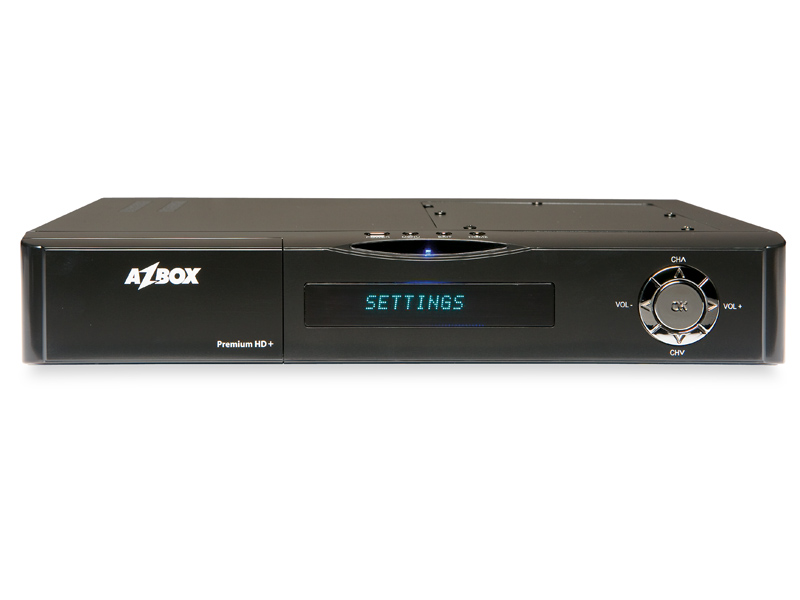TechRadar Verdict
Pros
- +
Strong AV performance, especially from HD
- +
Networkability
- +
Excellent multimedia playback
Cons
- -
Noisy fan
- -
Some user-interface issues
- -
Handset feels cheap and occasionally fails to respond
Why you can trust TechRadar
Twin tuners, HD-compatibility, hardware blind search, Ethernet and integrated 802.11b/g wireless networking, provision for an internal HDD and a comprehensive multimedia player. Most PVRs give you some, but not all, of these desirable features, but the Linux-powered Premium HD+ literally does go all of the way from A to Z.
Incredibly, all of this can be yours for around £380 sans HDD. We successfully added a 1.5TB drive, which are available for about £70 nowadays.
Appearance and connectivity
This fully loaded box is remarkably compact – largely because its power supply unit is an external 'brick'. Yet you get at least the usual complement of controls; in addition to a front-panel joypad disc that lives next to an 11-character fluorescent display is a selection of keys for menu access.
Behind a front-panel flap lives a USB port and the conditional access hardware, which takes the form of a pair of CI slots and an as-yet-unused card reader. The accompanying handset is packed with buttons that drive the unit's many functions, but has a rather tacky feel to it.
Connectivity is similarly comprehensive. The twin tuners, which are 'pluggable', have inputs and loopthrough outputs. Hopefully, AZBox will introduce a DVB-T2 tuner for UK terrestrial HDTV. Only one RGB capable Scart is provided. A bank of phono sockets output stereo analogue audio, composite and component video.
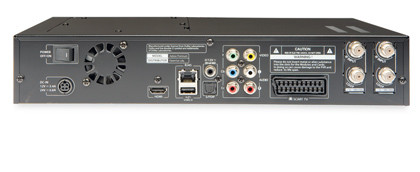
Above an optical digital audio output is a programmable 12V outlet for accessories like switchboxes. Next to these are the Ethernet and USB connectors, the latter usable for applying software upgrades and recording to external drives.
Finally, we have the HDMI port, which is 1080p-compatible. Nothing's currently being broadcast in this format but regular TV is upscaled or de-interlaced by the box.
Internally, this receiver is neatly laid out, packing a powerful SMP8634LF 'jungle chip', aided by plenty of memory.
Setup
A top-mounted screw-in plate yields access to the (SATA) HDD compartment. Installing the drive, which is screwed into an internal 'cradle', is straightforward enough.
Formatting is handled by a setup menu option. On which subject the Premium HD+ doesn't – unlike some other Linux-based receivers – rely on a derivative of the Enigma firmware.
Instead, it runs proprietary code –- you won't be able to find alternative firmware. That said, tools for developing plug-ins and applications are freely available from the AZBox website.
Specifying your outdoor equipment, defining satellites and channel searches are the remit of the 'TV Channel' setup option. The Premium HD+ will cater for two independent dishes aimed at different satellites, the PVR ideal of a twin LNB setup, or the least satisfactory option of a single LNB plus loopthrough.
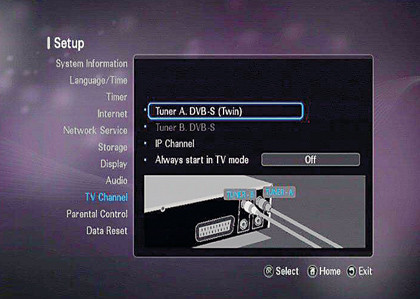
The next step is to define each satellite. The LNB type, and a DiSEqC switch 'position', can be specified if more than one satellite is available. A separate menu looks after DiSEqC 1.2 and USALS motorised dishes; this is quite flexible in so far as motor memory locations and movement step sizes can be entered manually.
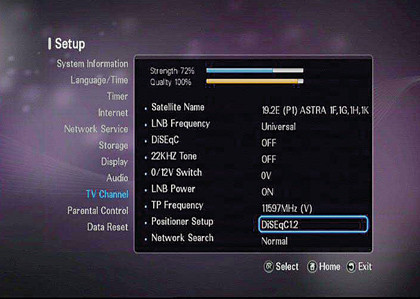
Signal strength and quality bars, plus the ability to choose a preset transponder, will assist searching. The basic search, 'satellite scan', looks for free and/or pay-TV and radio channels. Courtesy of a checkbox arrangement, multiple satellites can be selected.
If you know the parameters of the channel you're after the most flexible option is 'advanced scan'. This gives you control over frequency, symbol rate, polarity, modulation type (DVB-S/ S2) and FEC; PID entry is also allowed.
Blind search – a full hardware implementation – works by sniffing out transponders which are then searched for channels.
Basic use
'TV' is an option on the aforementioned carousel. There's no separate entry for 'radio' – you have to toggle between radio and TV modes with the handset.
When 'TV' is selected, the receiver goes to the last channel viewed. The list is selected by pressing 'OK'. Channels can be sorted alphabetically or according to encryption status, genre, satellite, provider or country. Press the 'back' button, and a specific satellite can be chosen.
Favourites (and categories) can be defined from the channel list – this function is available, together with the ability to edit, rename, move or delete channels, from a submenu. When changing channel, an 'info bar' displays the channel name and the current/next programme among other basic details – an 'info' key throws it onscreen at any other time.
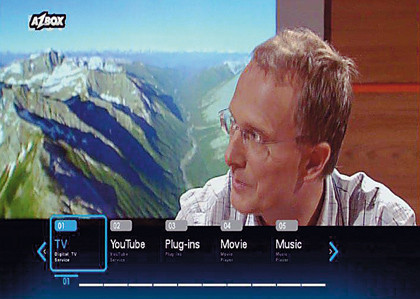
Annoyingly, there's no favourites button. Highlight the channel and the details are displayed near the bottom of the screen. Buttons are dedicated to subtitles, teletext, soundtrack selection and the EPG. This supports both now-and-next and seven-day schedules, and has two modes.
'Single EPG' is a scrollable list of all of the programmes available on a single channel. In the second 'multi-channel' mode a timeline shows simultaneously what's available on up to seven channels.
PVR and multimedia
The EPG can be used to program the timer and manual recording and timer-programming are also allowed. With a twin-LNB the Premium HD+'s tuner arrangement lets you record two different channels while watching a third (which must be on the same transponder as one of the others).
A major limitation is that you can't watch an existing recording or multimedia file when a new recording is in progress. Try to do so and you're prompted to stop the recording first.
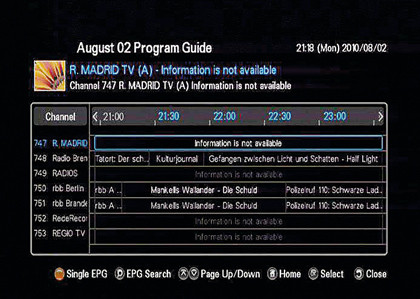
It's also a pity that no provision has been made for overlapping timer events on the same channel, so you're forced to record consecutive programmes as a large 'block'. Timeshifting is possible, although you have to engage it via the menus instead of merely pressing the 'pause' button.
Few other machines, though, currently offer the Premium HD+'s multimedia facilities for which it's a class leader. Compatible content can be transferred to the internal HDD via USB or the network. As an alternative it will play such files over the network if the PC folder they're stored in is 'shared'.
Format compatibility is superior to many standalone media players; particularly welcome are FLAC (lossless audio), ISO disc-images and MKV/X.264 (all the way to 1080p). YouTube playback is also featured, but no other form of internet video or radio is, alas, yet supported.
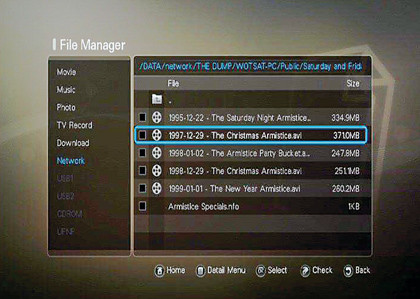
Other standouts are the ability to display RSS newsfeeds and the integrated web browser, which is compatible with most sites. Compared with PCs it's rather slow and awkward to navigate, although support for USB keyboards is claimed.
A tell-tale button suggests that an e-mail client is on the cards. But until this has been implemented you're stuck with webmail. Thanks to the onboard FTP server (and client) it's easy to transfer content like multimedia files and recordings to or from a PC.
Recordings are transport streams, easily handled by PC software like ProjectX and VLC. It's disappointing that there's no web interface for remote control or streaming. The Premium HD+ does, like Enigma, support plug-ins. However, only two are currently available.
Performance
Picture and sound are both exemplary, especially via HDMI. Here's a receiver that home cinema buffs will warm to, courtesy of its intricate detailing, sensibly balanced colours and the wide contrast range of its HD pictures.
SD pictures, upscaled to 1080p, also fare well if the source material is up to it. Multimedia playback of our high-quality test files is impressive too, although the Premium HD+ can be unforgiving with poor-quality material like budget channels and YouTube.
Sensitivity is fair; there were no problems with 'missing channels' troubling any of the main European satellites with our 1m dish and 0.2dB twin LNB.
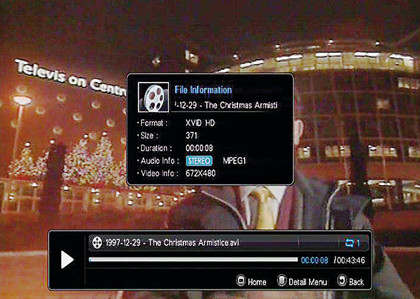
The Premium HD+ is capable of speedy searches; naturally, blind scan is signifi cantly slower. By how much depends on the step-size you define – 'finding-power' is traded off against speed.
Follow TechRadar Reviews on Twitter: http://twitter.com/techradarreview
